Shelly Fan in Singularity Hub:
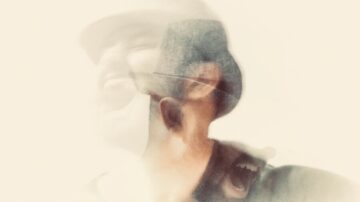 If you’ve ever vented to ChatGPT about troubles in life, the responses can sound empathetic. The chatbot delivers affirming support, and—when prompted—even gives advice like a best friend. Unlike older chatbots, the seemingly “empathic” nature of the latest AI models has already galvanized the psychotherapy community, with many wondering if they can assist therapy. The ability to infer other people’s mental states is a core aspect of everyday interaction. Called “theory of mind,” it lets us guess what’s going on in someone else’s mind, often by interpreting speech. Are they being sarcastic? Are they lying? Are they implying something that’s not overtly said?
If you’ve ever vented to ChatGPT about troubles in life, the responses can sound empathetic. The chatbot delivers affirming support, and—when prompted—even gives advice like a best friend. Unlike older chatbots, the seemingly “empathic” nature of the latest AI models has already galvanized the psychotherapy community, with many wondering if they can assist therapy. The ability to infer other people’s mental states is a core aspect of everyday interaction. Called “theory of mind,” it lets us guess what’s going on in someone else’s mind, often by interpreting speech. Are they being sarcastic? Are they lying? Are they implying something that’s not overtly said?
“People care about what other people think and expend a lot of effort thinking about what is going on in other minds,” wrote Dr. Cristina Becchio and colleagues at the University Medical Center Hanburg-Eppendorf in a new study in Nature Human Behavior.”
In the study, the scientists asked if ChatGPT and other similar chatbots—which are based on machine learning algorithms called large language models—can also guess other people’s mindsets. Using a series of psychology tests tailored for certain aspects of theory of mind, they pitted two families of large language models, including OpenAI’s GPT series and Meta’s LLaMA 2, against over 1,900 human participants. GPT-4, the algorithm behind ChatGPT, performed at, or even above, human levels in some tasks, such as identifying irony. Meanwhile, LLaMA 2 beat both humans and GPT at detecting faux pas—when someone says something they’re not meant to say but don’t realize it. To be clear, the results don’t confirm LLMs have theory of mind. Rather, they show these algorithms can mimic certain aspects of this core concept that “defines us as humans,” wrote the authors.
More here.
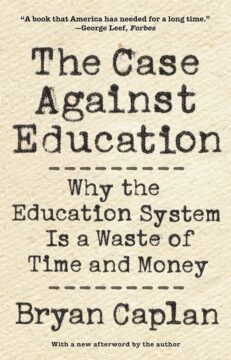 There’s been renewed debate around Bryan Caplan’s The Case Against Education recently, so I want to discuss one way I think about this question.
There’s been renewed debate around Bryan Caplan’s The Case Against Education recently, so I want to discuss one way I think about this question.
 I
I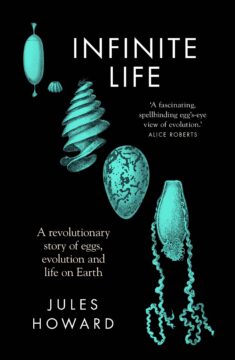 Jules Howard is no stranger to sex. A science writer and zoological correspondent, his gleefully amusing 2014 book
Jules Howard is no stranger to sex. A science writer and zoological correspondent, his gleefully amusing 2014 book  A
A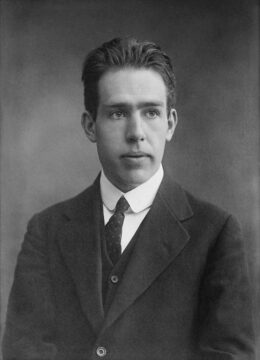 The quantum revolution in physics played out over a period of
The quantum revolution in physics played out over a period of  In the early fifth century BC, the Olympic boxer Kleomedes was disqualified from a match after killing his opponent with a foul move. Outraged at being deprived of the victory and its attendant prize, he became “mad with grief” and tore down a school in his hometown, killing many of the children who were studying there. Kleomedes managed to escape the angry mob that soon pursued him, and disappeared without trace. When the community sought answers from the oracle at Delphi, they were told that Kleomedes was now a hero, and should be honored accordingly with sacrifices. This the people did, and continued to do for centuries to come.
In the early fifth century BC, the Olympic boxer Kleomedes was disqualified from a match after killing his opponent with a foul move. Outraged at being deprived of the victory and its attendant prize, he became “mad with grief” and tore down a school in his hometown, killing many of the children who were studying there. Kleomedes managed to escape the angry mob that soon pursued him, and disappeared without trace. When the community sought answers from the oracle at Delphi, they were told that Kleomedes was now a hero, and should be honored accordingly with sacrifices. This the people did, and continued to do for centuries to come. Detective fiction in the West is often grouped with crime fiction and thrillers; but in detective fiction, the focus is on a puzzle and the process of solving it. It’s a game with the reader in which a mystery needs to be unraveled before the detective figures it out. In some places, the detective becomes a figure of interest in himself—detective figures have been, traditionally if less so at present, more often than not, men—a complex personality whose story is interesting and deserves an independent treatment of its own. It is a genre that solves problems, finds answers, holds the culprit accountable: all very attractive attributes for those who just like a good story.
Detective fiction in the West is often grouped with crime fiction and thrillers; but in detective fiction, the focus is on a puzzle and the process of solving it. It’s a game with the reader in which a mystery needs to be unraveled before the detective figures it out. In some places, the detective becomes a figure of interest in himself—detective figures have been, traditionally if less so at present, more often than not, men—a complex personality whose story is interesting and deserves an independent treatment of its own. It is a genre that solves problems, finds answers, holds the culprit accountable: all very attractive attributes for those who just like a good story. The latest wave of AI relies heavily on machine learning, in which software identifies patterns in data on its own, without being given any predetermined rules as to how to organize or classify the information. These patterns can be inscrutable to humans. The most advanced machine-learning systems use neural networks: software inspired by the architecture of the brain. They simulate layers of neurons, which transform information as it passes from layer to layer. As in human brains, these networks strengthen and weaken neural connections as they learn, but it’s hard to see why certain connections are affected. As a result, researchers often talk about AI as ‘
The latest wave of AI relies heavily on machine learning, in which software identifies patterns in data on its own, without being given any predetermined rules as to how to organize or classify the information. These patterns can be inscrutable to humans. The most advanced machine-learning systems use neural networks: software inspired by the architecture of the brain. They simulate layers of neurons, which transform information as it passes from layer to layer. As in human brains, these networks strengthen and weaken neural connections as they learn, but it’s hard to see why certain connections are affected. As a result, researchers often talk about AI as ‘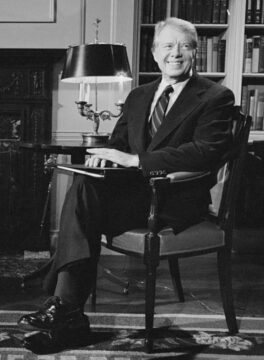 On September 17, 1978, U.S. President Jimmy Carter faced a momentous crisis. For nearly two weeks, he had been holed up at Camp David with Egyptian President Anwar al-Sadat and Israeli Prime Minister Menachem Begin, trying to hammer out a historic peace deal. Although the hard-liner Begin had proven intransigent on many issues, Carter had made enormous progress by going around him and negotiating directly with Israeli Foreign Minister Moshe Dayan, Defense Minister Ezer Weizman, and Legal Adviser Aharon Barak. On the 13th day, however, Begin drew the line. He announced he could compromise no further and was leaving. The talks on which Carter had staked his presidency would all be for naught.
On September 17, 1978, U.S. President Jimmy Carter faced a momentous crisis. For nearly two weeks, he had been holed up at Camp David with Egyptian President Anwar al-Sadat and Israeli Prime Minister Menachem Begin, trying to hammer out a historic peace deal. Although the hard-liner Begin had proven intransigent on many issues, Carter had made enormous progress by going around him and negotiating directly with Israeli Foreign Minister Moshe Dayan, Defense Minister Ezer Weizman, and Legal Adviser Aharon Barak. On the 13th day, however, Begin drew the line. He announced he could compromise no further and was leaving. The talks on which Carter had staked his presidency would all be for naught. Girard’s corpus is not just an erudite self-help manual, however; his intellectual landscape is not intended to be therapeutic, and yet it is. What he came to see was not a comfort, however, but something fierce and intractable. What he learned about the individual also limns the destiny of our species. Our impossible plight: the mechanism of scapegoat violence—whether on the level of the individual, or society, or epoch—is rooted in the very imitation that teaches us to love and learn, in fact, the very tissue that connects us with the rest of humanity.
Girard’s corpus is not just an erudite self-help manual, however; his intellectual landscape is not intended to be therapeutic, and yet it is. What he came to see was not a comfort, however, but something fierce and intractable. What he learned about the individual also limns the destiny of our species. Our impossible plight: the mechanism of scapegoat violence—whether on the level of the individual, or society, or epoch—is rooted in the very imitation that teaches us to love and learn, in fact, the very tissue that connects us with the rest of humanity. Have you ever said “I hate you” to someone? What about using the “h-word” in casual conversation, like “I hate broccoli”? What are you really feeling when you say that you hate something or someone?
Have you ever said “I hate you” to someone? What about using the “h-word” in casual conversation, like “I hate broccoli”? What are you really feeling when you say that you hate something or someone? If you’ve ever vented to ChatGPT about troubles in life, the responses can sound empathetic. The chatbot delivers affirming support, and—when prompted—even gives advice like a best friend. Unlike older chatbots, the seemingly “empathic” nature of the latest AI models has already galvanized the psychotherapy community, with
If you’ve ever vented to ChatGPT about troubles in life, the responses can sound empathetic. The chatbot delivers affirming support, and—when prompted—even gives advice like a best friend. Unlike older chatbots, the seemingly “empathic” nature of the latest AI models has already galvanized the psychotherapy community, with  My own tutee students, whom I met on a regular basis, were reporting poor mental health or asking for extensions because they were unable to meet deadlines that were stressing them out. They were overly obsessed with marks and other performance outcomes, and this impacted not only on them, but also on the teaching and support staff who were increasingly dealing with alleviating student anxiety. Students wanted more support that most felt was lacking and, in an effort to deal with the issue, the university had invested heavily, making more provision for mental health services. The problem with this strategy, however, is that by the time someone seeks out professional services, they are already at a crisis point. I felt compelled to do something.
My own tutee students, whom I met on a regular basis, were reporting poor mental health or asking for extensions because they were unable to meet deadlines that were stressing them out. They were overly obsessed with marks and other performance outcomes, and this impacted not only on them, but also on the teaching and support staff who were increasingly dealing with alleviating student anxiety. Students wanted more support that most felt was lacking and, in an effort to deal with the issue, the university had invested heavily, making more provision for mental health services. The problem with this strategy, however, is that by the time someone seeks out professional services, they are already at a crisis point. I felt compelled to do something.